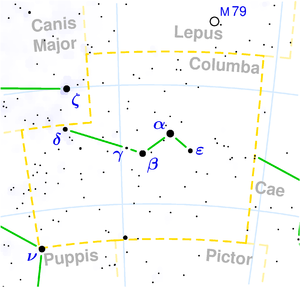 A small constellation of the southern sky, whose distorted line of stars lies south of the Canis Major and Lepus. Columba can be seen all above the horizon from areas as far south as the southernmost European shores. If we want the best view of its objects, we must wait for a time when it is passing through the meridian and the southern horizon is not obscured by fog, dust, or low cloud. The Columba contains a handful of binaries, a couple of moderately bright galaxies, and the pretty globular cluster NGC 1851.
A small constellation of the southern sky, whose distorted line of stars lies south of the Canis Major and Lepus. Columba can be seen all above the horizon from areas as far south as the southernmost European shores. If we want the best view of its objects, we must wait for a time when it is passing through the meridian and the southern horizon is not obscured by fog, dust, or low cloud. The Columba contains a handful of binaries, a couple of moderately bright galaxies, and the pretty globular cluster NGC 1851.
Phakt (α Col) - The brightest star of the constellation. The main pale blue component with a magnitude of 2.64 has a companion of 11 magnitude at a separation of 13.5 arcseconds, which can be seen with a 100mm telescope. The system is located 145 light-years away.
μ Col - A very interesting star, one of a trio diverging from the constellation Orion. Along with the stars 53 Ari and AE Aur, it likely once formed a stellar system in the constellation Orion, with its fourth component exploding as a supernova 2-3 billion years ago, disrupting the stability of the remaining three, which are gradually moving away from their original position. In our Galaxy, μ Col moves at a speed of about 100 km/s.
T Col - A variable star of the Mira type with a maximum magnitude of 6.7 and a minimum magnitude of 12.6. Its period is 266 days.
Herschel 3857 - We will see the triple star in the telescope with a 100 mm objective diameter as a nice wide yellow-orange pair of stars, with a brightness of 5.7 mag and 6.9 mag, respectively. The brighter component has a separation of 12.9 arcseconds from a fainter grayish-white companion with a magnitude of 10.8 mag.
NGC 1851
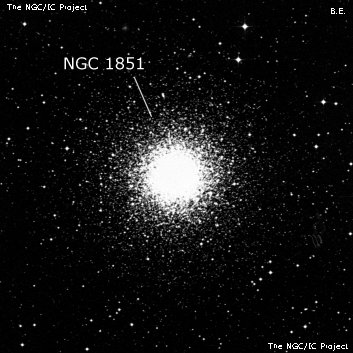
James Dunlop discovered NGC 1851 = D 508 = h2777 on 10 May 1826 with his 9-inch speculum f/12 reflector at Parramatta, New South Wales. His decription reads "exceedingly bright, round, well-defined nebula, about 1.5' diameter, exceedingly condensed, almost to the very margin. This is the brightest small nebula that I have seen. I tried several magnifying powers on this beautiful globe; a considerable portion round the margin is resolvable, but the compression to the centre is so great that I cannot reasonably expect to separate the stars. I compared this with the 68 Conn. des Tems, and this nebula greatly exceeds the 68 in condensation and brightness." Dunlop observed it 5 times.
John Herschel recorded it on 23 Oct 1835 as a "superb globular cluster; all resolved into stars of 14th mag.; very suddenly much brighter in the middle to a blaze or nucleus of light; diam. in RA = 15 seconds of time. Difference of left and right eyes in resolving this cluster very remarkable. Returning from the left to the right eye, the object (in comparison) appears as if glazed over with a kind of dull film." On a later sweep he wrote, "very bright; round; very suddenly very much brighter in the middle; 3'; all clearly resolved into stars from 14 to 16 mag except at the centre, where they are massed together into a blaze of light." His final observation reads "Superb globular cluster, very bright; round; first very gradually then suddenly very much brighter in the middle; 4'; resolved, the stars barely visible in strong twilight."
200/250mm - 8" (10/13/81): small, very small bright core, faint halo.
300/350mm - 13.1" (2/20/04 - Costa Rica): at 200x, this compact globular was very bright, strongly concentrated with an intense 1.5' core and a 4-5' fainter halo. The core was very lively and there were ~30 stars resolved [brightest cluster members are mag 13.2], mostly in the loose halo. A neat loop of stars emerges from the core and runs NNE-SSW along the west edge of the core.
13.1" (1/1/84): mottled bright core, unresolved except for two or three faint stars at the west edge.
400/500mm - 17.5" (1/31/87): small bright core, large very mottled halo. About 20 stars are resolved, mostly west of the core.
Notes by Steve Gottlieb
NGC 1808
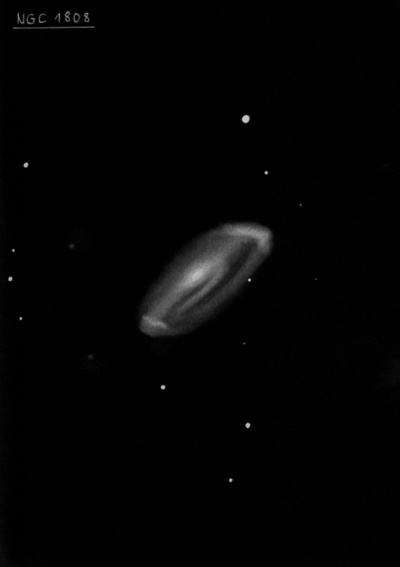
James Dunlop discovered NGC 1808 = D 549 = h2740 on 10 May 1826 and described "a faint nebula, about 2.5' long, and fully 1' broad, extended S.p. and N.f.; a very minute star near each extremity, not involved." He observed it on 2 occasions and his position was ~7' too far east. D 532 is probably a duplicate observation, but the position was off by 42' ESE.
John Herschel made two observations from the Cape. On 24 Dec 1835 he logged "B, L, lE, first gradually then psmbM. Transit missed, PD very rough" Two nights later he reobserved it and noted "B, E, 3' long, 1.5' broad; in a field strongly illuminated by the moon in her first quarter."
Joseph Turner sketched NGC 1808 with a very bright, elongated core on 19 Dec. 1876 using the 48" Great Melbourne Telescope (plate III, figure 26). See www.docdb.net/history/texts/1885osngmt________e/lithograph_m_3_26.php)
200/250mm - 8" (1/1/84): fairly bright, elongated NW-SE, moderately large, bright core. Similar in size to NGC 1792 but slightly fainter.
300/350mm - 13.1" (2/20/04 - Costa Rica): this 105x this striking starburst galaxy appeared bright, large, very elongated 4:1 NW-SE, 5'x1.3'. The glow is sharply concentrated with a well-defined 20" core that brightens to a stellar nucleus. There appears to be an irregular extension at the northwest end that brightens and is offset to the major axis [on photos this corresponds with the start of a spiral arm that is attached at the north edge of the NW end of the galaxy]. At 166x, the halo is irregular and mottled. Brightest in a group (LGG 127) along with NGC 1792 40' SW and the galaxies may have experienced a tidal interaction in the past.
400/500mm - 17.5" (1/31/87): bright, fairly large, small elongated core, long thin arms 4:1 NW-SE. A mag 14 star is off the NW end. This is a very pleasing galaxy.
Notes by Steve Gottlieb
NGC 1792
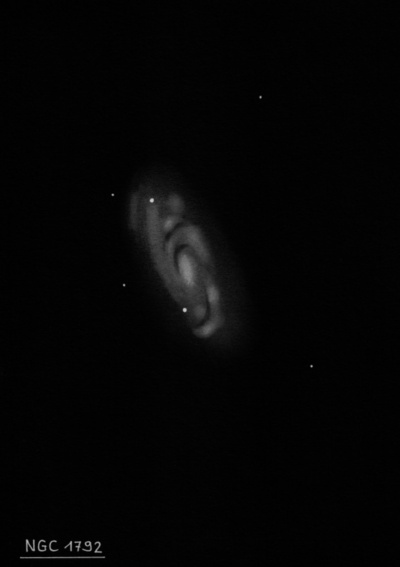
James Dunlop discovered NGC 1792 = D 531 = h2730 on 4 Oct 1826 and described "a long or rather elliptical nebula, about 2' long and 50" broad, a little brighter in the middle, and well defined. There is a group of small stars on the north side." JH lists 3 observations in the Cape Catalogue: on his first sweep on 24 Dec 1835 he logged "vB, vL, vmE, gbM, 4' long. Taken as Dunlop 531 but too late for transit, the observation having been missed by relying on Mr Dunlop's place." Then 2 nights later he revisited this galaxy and noted "vB, vL, mE, glbM, 5' long, 2' broad, pos 314?, stars seen in it. Visible with moonlight and lamp illumination". Finally on a third sweep he noted "B, vL, mE, regular elliptic; resolved. I see several small stars in it."
This starburst spiral has a mean distance of ~42 million light years and spans 70,000 l.y. across. We view it inclined ~28? from edge-on.
200/250mm - 8" (1/1/84): moderately bright, moderately large, slightly elongated.
8" (11/28/81): fairly faint, round, moderately large, diffuse.
300/350mm - 13.1" (2/20/04 - Costa Rica): at 105x appears as a bright, large oval ~2:1 NW-SE, 3.2'x1.6'. Broad concentration to a large bright core and then sharply concentrated with a bright, 15" nucleus. The surface brightness is irregular with a mottled texture. A faint star is just preceding the northwest tip. At 166x the galaxy appears brighter along the major axis with some areas of lower surface brightness giving a hint of spiral structure! A mag 14 star is at the preceding edge [1.2' from center]. Brightest in a group (LGG 127) along with NGC 1808 40' NE.
400/500mm - 17.5" (1/31/87): bright, large, elongated 2:1 NW-SE, 3'x1.5', pretty diffuse. Two faint mag 14.5 stars are superimposed. Appears brighter along the western side.
Notes by Steve Gottlieb
NGC 2090
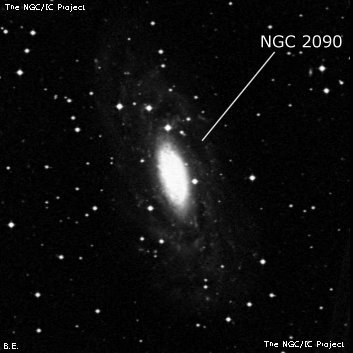
James Dunlop discovered NGC 2090 = D 594 = h2944 on 29 Oct 1826 and described "a small faint nebula, with a ray shooting out on the north side." Dunlop observed this galaxy once and his position is 3' too far SSW. The "ray" he mentions probably consists of 3 mag 13-14 stars. John Herschel recorded the galaxy twice, on 8 Jan 1836 recording a "globular cluster, B; R; with an appendage to northward; 2.5' diameter." The following night he described it as "B, irreg R, gbM; 3' long; 2' broad with stars appended. This RA to be preferred". Herschel called this galaxy a globular in the GC and Dreyer copied that classification in the NGC description.
300/350mm - 13.1" (2/25/84): faint, fairly small, very elongated 3:1 ~N-S, 2.5'x0.8'. A mag 13.5 star is at the north tip 1.5' from center, a mag 14 star is at the west edge, 40" from center and another 14th mag star is 1.2' SE.
Notes by Steve Gottlieb
NGC 2188
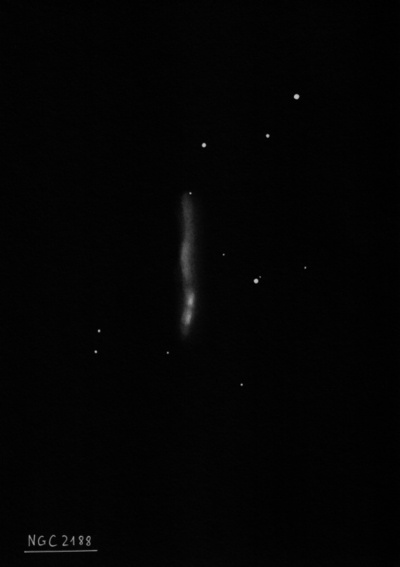
John Herschel discovered NGC 2188 = h3022 on 9 Jan 1836 and described as "pF, vmE, gvlbM, 2' long." His position is accurate.
300/350mm - 13.1" (2/23/85): faint, moderately large, edge-on streak 6:1 NNW-SSE. A mag 13.5 star is at the NNW end. Located 7.8' NE of mag 8.6 SAO 196541.
600/800mm - 24" (1/25/14): at 200x and 260x; fairly bright, large, very elongated 5:1 N-S, 4.0'x0.8', broad concentration with a large, slightly brighter elongated core. Mag 8.5 HD 42519 lies 8' SW. ESO 364-039 lies 16' NE and ESO 364-035/036, in the core of AGC 3391, are 28' N.
NGC 2188 is an edge-on Magellanic dwarf irregular with several giant HII regions on the south side and appears to be disrupted, although there are no nearby interacting companions.
Notes by Steve Gottlieb
NGC 1827
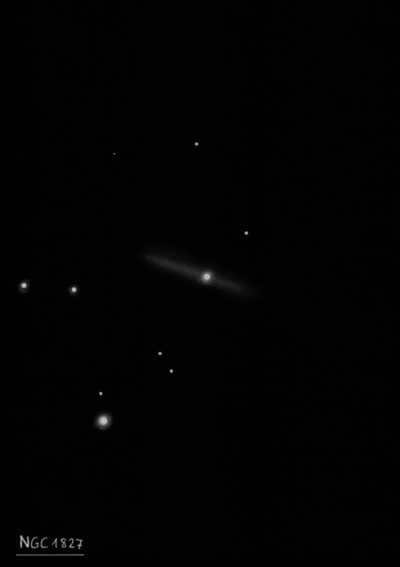
John Herschel discovered NGC 1827 = h2751 on 28 Nov 1837 and described as "vF, vmE, a long ray through a star 11th mag." His position is 1' too far south.
400/500mm - 17.5" (1/19/91): faint, fairly large, edge-on 5:1 WNW-ESE, even surface brightness. Unusual appearance as a mag 11 star is superimposed on the east side of the center. Member of the NGC 1792/1808 group.
Notes by Steve Gottlieb
IC 2136
400/500mm - 17.5" (2/22/03): large, low surface brightness edge-on, elongated nearly 4:1 WNW-ESE, 1.5'x0.4'. Viewed at a very low elevation west of the meridian. A mag 9.7 star is 5.4' SW. Located 14' E of the scattered group NGC 1963.
Notes by Steve Gottlieb